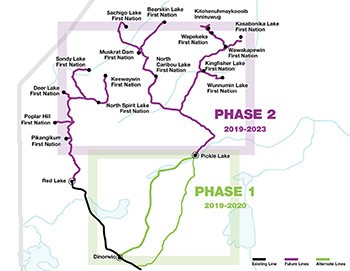
Feds commit $1.6B to connect 16 Northern Ontario First Nations to the grid
March 23, 2018
By
CCE
The Wataynikaneyap Power Project will connect First Nations who currently rely on diesel generation to the Ontario transmission grid.

(source: government of Canada)
Federal and Ontario politicians were on hand for the announcement of $1.6 billion in federal funding for Wataynikaneyap Power to connect 16 First Nations in Northern Ontario to the provincial electricity power grid.
The Wataynikaneyap Power Project is the largest and most far-reaching Indigenous-led transmission project in the history of the province.
Wataynikaneyap Power, a transmission company majority owned by 22 First Nation communities, has played a role in leading the project.
The Wataynikaneyap Power Project will connect First Nations who currently rely on diesel generation to the Ontario transmission grid; representing a population of over 14,000.
Following the grid connection to Pikangikum First Nation, the Wataynikaneyap Power Project is scheduled to be accomplished as one project, in two phases:
- Phase 1: upgrading of the electrical system with a new line to Pickle Lake, Ont. is expected to begin in early 2019 with completion in late 2020.
- Phase 2: construction for the connection of remote First Nation communities north of Red Lake and Pickle Lake will begin in 2019, with community connections starting in 2021, and all communities connected by the end of 2023.
“Reducing reliance on diesel power in 16 remote Ontario First Nations is truly something to celebrate. This partnership between Ontario, Canada, and Wataynikaneyap Power will support economic growth, help reduce greenhouse gas pollution, reduce fire risk in communities, and reduce reliance on winter roads,” said Minister David Zimmer, Ontario Minister of Indigenous Relations and Reconciliation, in a media release.
- In Ontario, 25 remote First Nations rely on diesel generation as their sole source of electricity, which has limited community growth and access to economic opportunities with all the challenges of fuel delivery and environmental disadvantages.
- In 2014, a study undertaken by the Ontario’s Independent Electricity System Operator determined that there was a positive business case to extend the provincial electricity grid to 21 of the 25 First Nations which are currently diesel dependent.
- The Wataynikaneyap Power project will connect 16 of those First Nations (Bearskin Lake, Deer Lake, Kasabonika Lake, Keewaywin, Kingfisher Lake, Kitchenuhmaykoosib Inninuwug, Muskrat Dam, North Caribou Lake, North Spirit Lake, Pikangikum, Poplar Hill, Sachigo Lake, Sandy Lake, Wapekeka, Wawakapewin, and Wunnumin Lake First Nations).
- Constructing of a transmission line to Pikangikum First Nation is already underway by Wataynikaneyap Power, scheduled for completion by late 2018.
- Wataynikaneyap Power, a licenced transmission company, owned by 22 First Nations (51%), with partner Fortis Inc. (49%), will connect the 16 communities to the provincial grid in northwestern Ontario with the goal of an eventual 100% ownership by First Nations.
- In order to address energy affordability, Ontario enhanced the Ontario Electricity Support Program (OESP), and introduced the First Nation Delivery Credit (FNDC) providing a 100 percent credit of the delivery charge to on-reserve First Nation households that are customers of licensed electricity distributors.